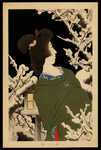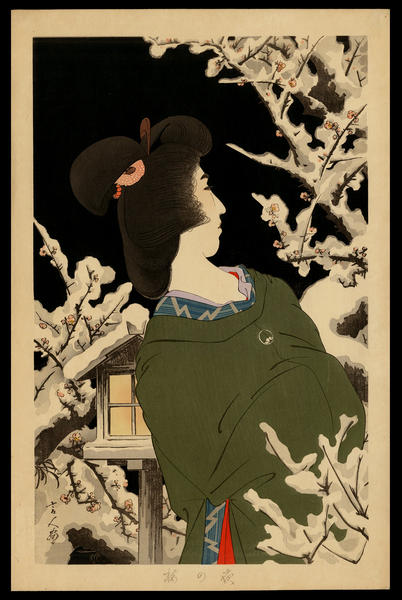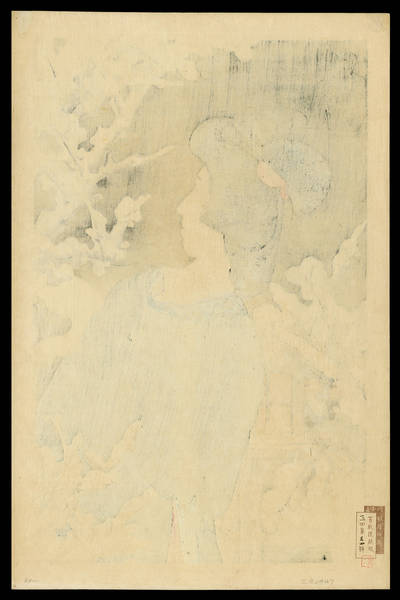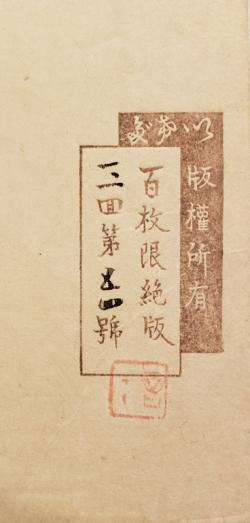| | |
| Artist: | Torii Kotondo (1900-1976) — 鳥居言人 |
| Title: | Plum Blossoms at Night (black background) — 梅の夜 |
| Series: | |
| Date of first edition?: | 1934 |
| Publisher (first edition)?: | Ikeda — 池田 |
| Publisher (this edition)?: | Ikeda — 池田 |
| Medium (first edition): | Woodblock |
| Medium (this edition): | Woodblock |
| Format (first edition): | Large Oban
|
| Format (this edition): | Large Oban |
| DB artwork code: | 47306 |
| Notes (first edition)?: |
Dated 1934 (confirmed. Month not yet confirmed).
Limited edition of only 100 prints. Apparently the blocks used for this scene still exist (according to Kotondo's family).
Scene number 11 among 12 Ikeda published scenes. Strangely, some appear to be marked as scene number 3, but "Tipsy", published in 1932 is undoubtedly scene number 3, and this scene "Plum Blossoms at Night" was published in 1934 (toward the end of the series) so I can't see how it can be scene number 3.
This scene has two colour variants: one with a black background and one with a light grey background. |
|
| Notes (this edition)?: |
| The following information was taken from the original web listing of this artwork. Note that there may be some inaccuracies:
ARTIST: Kotondo, Torii, 1900-1977
SIZE: 15 3/4 x 9 7/8 inches
CATEGORY: Shin Hanga
DESCRIPTION: Title: Japanese Apricot Tree in the Night
MEDIUM: woodblock
Edition: 54/100
Date: 1934
Illustrated: Female Image, pl. 186-1
Notes: Published by Ikeda
CONDITION: Slight toning |
|
| Artist Bio: |
| Torii Kotondo (or Torii Kiyotada VIII) is renowned for his paintings and shin hanga prints of beautiful women. His woodblock prints, superbly carved and printed, are comparable with those of Hashiguchi Goyo and Ito Shinsui. Kotondo was born with the name Saito Akira in the Nihonbashi district of Tokyo. He was the only son among the five children of Torii Kiyotada, the seventh Torii master. The Torii school had a long tradition of painting and printmaking for the Japanese theater, extending back to the seventeenth century. Kabuki theater was still very popular in the early twentieth century and prints and painted posters were the primary means of publicity. Although Kotondo was mainly interested in studying history and archaeology, it was assumed that he would follow in his father's footsteps and join the Torii school. At age 14, Kotondo agreed to leave school and begin studies with Kobori Tomone, a yamato-e painter. Along with painting classes, Tomone taught Kotondo about the court and military practices of ancient Japan, satisfying his interest in history. A year later, he was officially adopted as the next heir of the Torii school and assumed the artist's name 'Kotondo'. While still studying with Tomone, he began designing illustrations for a theatrical magazine, Engei Gaho ('Entertainment Illustrated Magazine'), and painted kabuki posters and billboards. Torii Kotondo was the 8th Torii and the 5th Torii Kiyotada. His father was the 4th Kiyotada.
|
|







